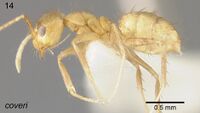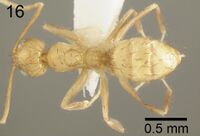Nylanderia coveri
| Nylanderia coveri | |
|---|---|

| |
| Scientific classification | |
| Kingdom: | Animalia |
| Phylum: | Arthropoda |
| Class: | Insecta |
| Order: | Hymenoptera |
| Family: | Formicidae |
| Subfamily: | Formicinae |
| Tribe: | Lasiini |
| Genus: | Nylanderia |
| Species: | N. coveri |
| Binomial name | |
| Nylanderia coveri LaPolla & Kallal, 2019 | |
The type series was collected in a nutmeg-banana plantation. It was found in a rotten stick, partly buried in leaf-litter, in the shade.
Identification
LaPolla and Kallal (2019) - Body bright yellow, with sharply contrasting brown macrosetae across body.
Compare with: Nylanderia guatemalensis
This species can be confused with N. guatemalensis when it is more yellow than brown, but preliminary molecular data clearly separates it from N. guatemalensis. The molecular results place Nylanderia coveri within a clade containing N. guatemalensis and Nylanderia steinheili. This species is another example of a small yellow species having workers that are difficult to separate from the widespread sometimes yellow, but color variable N. guatemalensis (the other example being Nylanderia lucayana). Overall once you have looked at enough N. guatemalensis the bright yellow color of N. coveri is actually distinctly different, contrasting sharply with the dark brown macrosetae. Generally, N. guatemalensis is never this bright yellow. Additionally, even in yellow specimens of N. guatemalensis the mesocoxae and metacoxae are always lighter than the remainder of the body. In N. coveri, the entire body, including the mesocoxae and metacoxae is bright yellow. Other than molecular data the penial sclerites also support recognition of this species with the proximal ventral extension coming much more to a point than it does in both N. guatemalensis and N. steinheili.
Keys including this Species
Distribution
Distribution based on Regional Taxon Lists
Neotropical Region: Grenada (type locality).
Distribution based on AntMaps
Distribution based on AntWeb specimens
Check data from AntWeb
Countries Occupied
| Number of countries occupied by this species based on AntWiki Regional Taxon Lists. In general, fewer countries occupied indicates a narrower range, while more countries indicates a more widespread species. |

|
Estimated Abundance
| Relative abundance based on number of AntMaps records per species (this species within the purple bar). Fewer records (to the left) indicates a less abundant/encountered species while more records (to the right) indicates more abundant/encountered species. |

|
Biology
Castes
Male
Nomenclature
The following information is derived from Barry Bolton's Online Catalogue of the Ants of the World.
- coveri. Nylanderia coveri LaPolla & Kallal, 2019: 412, figs. 14-18 (w.m.) GRENADA.
Unless otherwise noted the text for the remainder of this section is reported from the publication that includes the original description.
Description
Worker
(n=4): TL: 1.98–2.13; HW: 0.46–0.50; HL: 0.59–0.63; EL: 0.15–0.17; SL: 0.68– 0.72; WL: 0.69–0.78; GL: 0.85–0.93. SMC: 14–19; PMC: 2; MMC: 2–3. indices: CI: 79–82; REL: 25–28; SI: 140–149; SI2: 22–25. Head: sides of head in full face view nearly parallel; posterolateral corner rounded; posterior margin straight; anterior clypeal margin evenly rounded; ocelli absent; eye well-developed. Mesosoma: in lateral view, pronotum convex; anterior margin of mesonotum raised slightly above posterior pronotal margin; metanotal area with short flat area anterior of spiracle; dorsal face of propodeum slightly convex; dorsal face of propodeum and mesonotum approximately the same height in lateral view. Color and pilosity: bright yellow; becoming slightly lighter to almost white distally on funiculus and legs; head, pronotum, mesonotum, propodeal dorsal face and gastral tergite I with abundant pubescence.
Male
(n=2): TL: 2.15; HW: 0.39–0.44; HL: 0.49–0.50; EL: 0.22–0.21; SL: 0.72; WL: 0.76– 0.77; GL: 0.88. SMC: 3–7; PMC: 0; MMC: 11–20. indices: CI: 78–88; REL: 41–44; SI: 184. Head: sides of head in full face view rounded; posterior margin rounded; clypeus emarginate anteriorly; mandible with apical tooth and much smaller, often indistinct, subapical tooth adjacent to apical tooth; basal angle sharp and distinct. Mesosoma: in lateral view, dorsal margin of mesoscutum same as height as dorsal margin of mesoscutellum. Genitalia: gonopod apex nearly triangular in lateral view; gonopods in dorsal view distally divergent with remainder of gaster; digitus with pointed apex that bends away from penial sclerite; cuspis tubular, rounded at apex bending sharply toward digitus; anteroventral process of penial sclerite pointed; valvura of penial sclerite placed slightly ventral to midline (fig. 105). Color and pilosity: bright yellow; becoming slightly lighter to almost white distally on funiculi and legs; head, pronotum, mesonotum, dorsal face of propodeum and gaster with abundant pubescence; on gaster macrosetae become more abundant posteriorly.
Type Material
Holotype worker, GRENADA: Saint Andrew Parish, 1.0 mi WNW of Lower Capital on road to Gouave (measured to junction of north-south road), 19-VI-1995, SP Cover, SPC G-148 (Museum of Comparative Zoology); 7 paratype workers and 2 paratype males with same locality data as holotype (National Museum of Natural History & MCZC).
Etymology
Named after myrmecologist Stefan P. Cover (Harvard University, Museum of Comparative Zoology), collector of this species and whose field skills for finding new and unusual ant species are unmatched.
References
- LaPolla, J.S., Kallal, R.J. 2019. Nylanderia of the World Part III: Nylanderia in the West Indies. Zootaxa 4658 (3): 401–451 (doi:10.11646/zootaxa.4658.3.1).
- Williams, J.L., Zhang, Y.M., LaPolla, J.S., Schultz, T.R., Lucky, A. 2022. Phylogenetic delimitation of morphologically cryptic species in globetrotting Nylanderia (Hymenoptera: Formicidae) species complexes. Insect Systematics and Diversity 6 (1): 10:1-15 (doi:10.1093/isd/iaxb027).
- Williams, J.L., Zhang, Y.M., Lloyd, M.W., LaPolla, J.S., Schultz, T.R., Lucky, A. 2020. Global domination by crazy ants: phylogenomics reveals biogeographical history and invasive species relationships in the genus Nylanderia (Hymenoptera: Formicidae). Systematic Entomology 45, 730–744 (doi:10.1111/syen.12423).
References based on Global Ant Biodiversity Informatics
- LaPolla J. S., and R. J. Kallal. 2019. Nylanderia of the World Part III: Nylanderia in the West Indies. Zootaxa 4658: 401-451.


